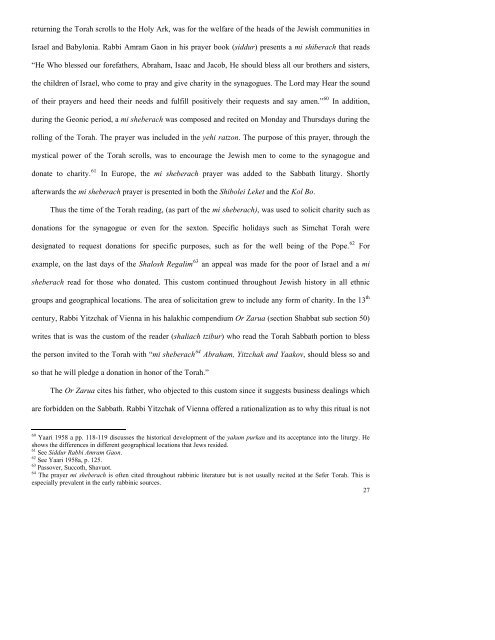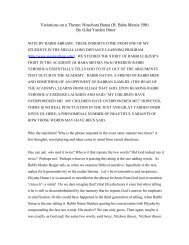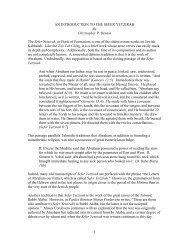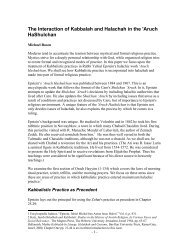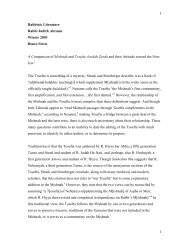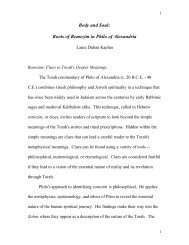The Symbolic Representation of the Sefer Torah - Maqom
The Symbolic Representation of the Sefer Torah - Maqom
The Symbolic Representation of the Sefer Torah - Maqom
Create successful ePaper yourself
Turn your PDF publications into a flip-book with our unique Google optimized e-Paper software.
eturning <strong>the</strong> <strong>Torah</strong> scrolls to <strong>the</strong> Holy Ark, was for <strong>the</strong> welfare <strong>of</strong> <strong>the</strong> heads <strong>of</strong> <strong>the</strong> Jewish communities inIsrael and Babylonia. Rabbi Amram Gaon in his prayer book (siddur) presents a mi shiberach that reads“He Who blessed our forefa<strong>the</strong>rs, Abraham, Isaac and Jacob, He should bless all our bro<strong>the</strong>rs and sisters,<strong>the</strong> children <strong>of</strong> Israel, who come to pray and give charity in <strong>the</strong> synagogues. <strong>The</strong> Lord may Hear <strong>the</strong> sound<strong>of</strong> <strong>the</strong>ir prayers and heed <strong>the</strong>ir needs and fulfill positively <strong>the</strong>ir requests and say amen.” 60 In addition,during <strong>the</strong> Geonic period, a mi sheberach was composed and recited on Monday and Thursdays during <strong>the</strong>rolling <strong>of</strong> <strong>the</strong> <strong>Torah</strong>. <strong>The</strong> prayer was included in <strong>the</strong> yehi ratzon. <strong>The</strong> purpose <strong>of</strong> this prayer, through <strong>the</strong>mystical power <strong>of</strong> <strong>the</strong> <strong>Torah</strong> scrolls, was to encourage <strong>the</strong> Jewish men to come to <strong>the</strong> synagogue anddonate to charity. 61In Europe, <strong>the</strong> mi sheberach prayer was added to <strong>the</strong> Sabbath liturgy. Shortlyafterwards <strong>the</strong> mi sheberach prayer is presented in both <strong>the</strong> Shibolei Leket and <strong>the</strong> Kol Bo.Thus <strong>the</strong> time <strong>of</strong> <strong>the</strong> <strong>Torah</strong> reading, (as part <strong>of</strong> <strong>the</strong> mi sheberach), was used to solicit charity such asdonations for <strong>the</strong> synagogue or even for <strong>the</strong> sexton. Specific holidays such as Simchat <strong>Torah</strong> weredesignated to request donations for specific purposes, such as for <strong>the</strong> well being <strong>of</strong> <strong>the</strong> Pope. 62Forexample, on <strong>the</strong> last days <strong>of</strong> <strong>the</strong> Shalosh Regalim 63 an appeal was made for <strong>the</strong> poor <strong>of</strong> Israel and a misheberach read for those who donated. This custom continued throughout Jewish history in all ethnicgroups and geographical locations. <strong>The</strong> area <strong>of</strong> solicitation grew to include any form <strong>of</strong> charity. In <strong>the</strong> 13 thcentury, Rabbi Yitzchak <strong>of</strong> Vienna in his halakhic compendium Or Zarua (section Shabbat sub section 50)writes that is was <strong>the</strong> custom <strong>of</strong> <strong>the</strong> reader (shaliach tzibur) who read <strong>the</strong> <strong>Torah</strong> Sabbath portion to bless<strong>the</strong> person invited to <strong>the</strong> <strong>Torah</strong> with “mi sheberach 64 Abraham, Yitzchak and Yaakov, should bless so andso that he will pledge a donation in honor <strong>of</strong> <strong>the</strong> <strong>Torah</strong>.”<strong>The</strong> Or Zarua cites his fa<strong>the</strong>r, who objected to this custom since it suggests business dealings whichare forbidden on <strong>the</strong> Sabbath. Rabbi Yitzchak <strong>of</strong> Vienna <strong>of</strong>fered a rationalization as to why this ritual is not60 Yaari 1958 a pp. 118-119 discusses <strong>the</strong> historical development <strong>of</strong> <strong>the</strong> yakum purkan and its acceptance into <strong>the</strong> liturgy. Heshows <strong>the</strong> differences in different geographical locations that Jews resided.61 See Siddur Rabbi Amram Gaon.62 See Yaari 1958a, p. 125.63 Passover, Succoth, Shavuot.64 <strong>The</strong> prayer mi sheberach is <strong>of</strong>ten cited throughout rabbinic literature but is not usually recited at <strong>the</strong> <strong>Sefer</strong> <strong>Torah</strong>. This isespecially prevalent in <strong>the</strong> early rabbinic sources.27


